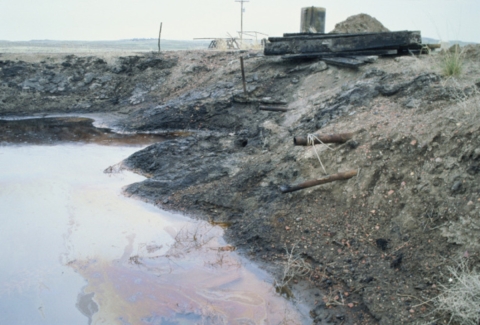Oil and gas exploration and extraction use and generate substantial volumes of water. The generated water, known as produced water, is the largest byproduct of the oil and gas industry. Produced water contains a mix of oil and other hydrocarbons, drilling muds and fluids, salts, heavy metals, surfactants, and other chemicals. Most produced water is saltier than seawater and ranges in salinity from ≤ 1% to greater than 50%. For reference the salinity of seawater is 3.5%.
During oil well drilling and operation, water and other waste fluids like drilling muds, concentrated salts, hydrocarbons, and toxic materials are produced. To separate the crude oil from produced water and other drilling fluids, different earthen pits are constructed including reserve pits, skim pits, and flare pits. Once the drilling fluids have been separated, they are typically disposed of in evaporation ponds. These open-top pits, tanks, and containers pose a threat to migratory birds.
How does oiled and produced water impact migratory birds?
Take of migratory birds can occur through entrapment in pits, ponds, and other equipment. Migratory birds may mistake oiled and produced waters for wetlands or other safe bodies of water and become entrapped. They may also be drawn to trapped prey. Birds risk death from oil exposure, which compromises insulation and causes poisoning through ingestion. Once entrapped, they may struggle to escape due to sticky oil, impaired feathers, or steep, synthetically lined pit walls. Birds that land in pits may become covered with oil and can ultimately die from drowning, starvation, temperature stress, or the effects of ingested oil.
What can I do to avoid and minimize impacts to birds?
Solutions to preventing bird mortality in oil pits and evaporation ponds are fairly simple and are being implemented by many oil operators. Closed-loop systems reduce the amount of drilling waste produced, require little to no maintenance, and can be moved from site to site, potentially reducing operator costs. These systems are the most effective measure to prevent bird exposure to oil and other hazardous chemicals and can eliminate soil contamination and remediation expense.
If a closed-loop system or closed tanks are not feasible, the Service recommends that all open containers be covered in a manner that does not entangle or entrap birds and is constructed and maintained to remain intact above the surface of the container. The most common practice used for bird exclusion is the installation of bird safe netting above the surface of liquid. This method is effective for pits up to approximately 1 acre in size. However, attempting to install and maintain netting over an area greater than 1 acre may be prohibitively expensive and require routine maintenance to avoid sag. Pits greater than 1 acre my require additional methods, such as active hazing, to prevent birds from becoming entrapped. Any oil or waste fluid spill or leak should be cleaned up immediately.
Library Documents
If you would like to provide comments on the information presented on this webpage, please contact the USFWS Migratory Bird Program at MigratoryBirds@fws.gov.




